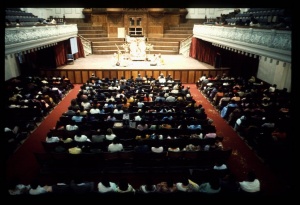CC Madhya 20.354: Difference between revisions
m (1 revision(s)) |
No edit summary |
||
| Line 1: | Line 1: | ||
{{ | [[Category:Sri Caitanya-caritamrta - Madhya-lila Chapter 20|C354]] | ||
<div style="float:left">'''[[Sri Caitanya-caritamrta|Śrī Caitanya-caritāmṛta]] - [[CC Madhya|Madhya-līlā]] - [[CC Madhya 20|Chapter 20: Lord Śrī Caitanya Mahāprabhu Instructs Sanātana Gosvāmī in the Science of the Absolute Truth]]'''</div> | |||
<div style="float:right">[[File:Go-previous.png|link=CC Madhya 20.353|Madhya-līlā 20.353]] '''[[CC Madhya 20.353|Madhya-līlā 20.353]] - [[CC Madhya 20.355|Madhya-līlā 20.355]]''' [[File:Go-next.png|link=CC Madhya 20.355|Madhya-līlā 20.355]]</div> | |||
{{CompareVersions|CC|Madhya 20.354|CC 1975|CC 1996}} | |||
{{RandomImage}} | |||
==== TEXT 354 ==== | ==== TEXT 354 ==== | ||
<div | <div class="verse"> | ||
avatāra nāhi kahe—‘āmi avatāra’ | :avatāra nāhi kahe—‘āmi avatāra’ | ||
muni saba lāni’ kare lakṣaṇa-vicāra | :muni saba lāni’ kare lakṣaṇa-vicāra | ||
</div> | </div> | ||
| Line 12: | Line 16: | ||
==== SYNONYMS ==== | ==== SYNONYMS ==== | ||
<div | <div class="synonyms"> | ||
''avatāra''—the actual incarnation of Godhead; ''nāhi''—never; ''kahe''—says; ''āmi avatāra''—I am an incarnation; ''muni''—the great sage Mahāmuni Vyāsadeva; ''saba jāni’''—knowing all (past, present and future); ''kare lakṣaṇa-vicāra''—describes the symptoms of the ''avatāras''. | |||
</div> | </div> | ||
| Line 19: | Line 23: | ||
==== TRANSLATION ==== | ==== TRANSLATION ==== | ||
<div | <div class="translation"> | ||
“An actual incarnation of God never says ‘I am God’ or ‘I am an incarnation of God.’ The great sage Vyāsadeva, knowing all, has already recorded the characteristics of the avatāras in the śāstras. | “An actual incarnation of God never says ‘I am God’ or ‘I am an incarnation of God.’ The great sage Vyāsadeva, knowing all, has already recorded the characteristics of the avatāras in the śāstras. | ||
</div> | </div> | ||
| Line 26: | Line 30: | ||
==== PURPORT ==== | ==== PURPORT ==== | ||
<div | <div class="purport"> | ||
In this verse it is clearly stated that a real incarnation of God never claims to be a real incarnation. According to the symptoms described in the śāstra, one can understand who is an avatāra and who is not. | In this verse it is clearly stated that a real incarnation of God never claims to be a real incarnation. According to the symptoms described in the ''śāstra'', one can understand who is an ''avatāra'' and who is not. | ||
</div> | </div> | ||
__NOTOC__ | |||
<div style="float:right; clear:both;">[[File:Go-previous.png|link=CC Madhya 20.353|Madhya-līlā 20.353]] '''[[CC Madhya 20.353|Madhya-līlā 20.353]] - [[CC Madhya 20.355|Madhya-līlā 20.355]]''' [[File:Go-next.png|link=CC Madhya 20.355|Madhya-līlā 20.355]]</div> | |||
__NOTOC__ | |||
__NOEDITSECTION__ | |||
Revision as of 02:15, 8 September 2021
Śrī Caitanya-caritāmṛta - Madhya-līlā - Chapter 20: Lord Śrī Caitanya Mahāprabhu Instructs Sanātana Gosvāmī in the Science of the Absolute Truth

His Divine Grace
A.C. Bhaktivedanta Swami Prabhupada
A.C. Bhaktivedanta Swami Prabhupada
TEXT 354
- avatāra nāhi kahe—‘āmi avatāra’
- muni saba lāni’ kare lakṣaṇa-vicāra
SYNONYMS
avatāra—the actual incarnation of Godhead; nāhi—never; kahe—says; āmi avatāra—I am an incarnation; muni—the great sage Mahāmuni Vyāsadeva; saba jāni’—knowing all (past, present and future); kare lakṣaṇa-vicāra—describes the symptoms of the avatāras.
TRANSLATION
“An actual incarnation of God never says ‘I am God’ or ‘I am an incarnation of God.’ The great sage Vyāsadeva, knowing all, has already recorded the characteristics of the avatāras in the śāstras.
PURPORT
In this verse it is clearly stated that a real incarnation of God never claims to be a real incarnation. According to the symptoms described in the śāstra, one can understand who is an avatāra and who is not.